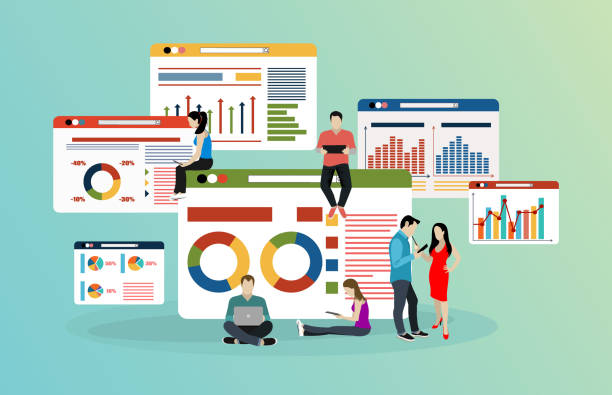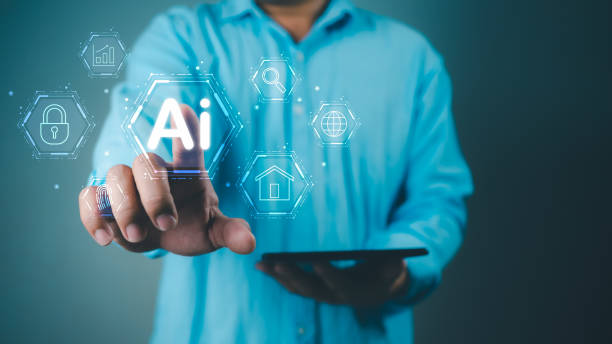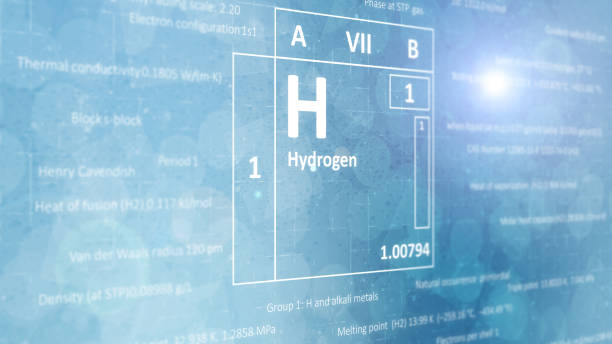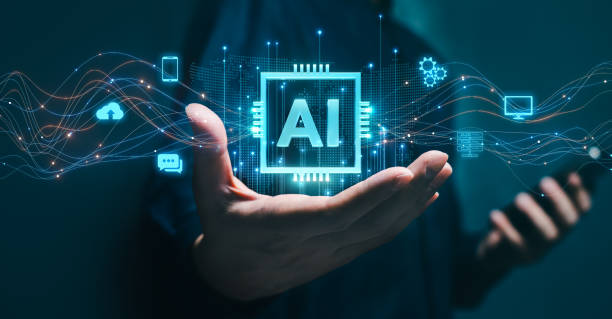Introduction to Modern UI Website Design and Its Importance
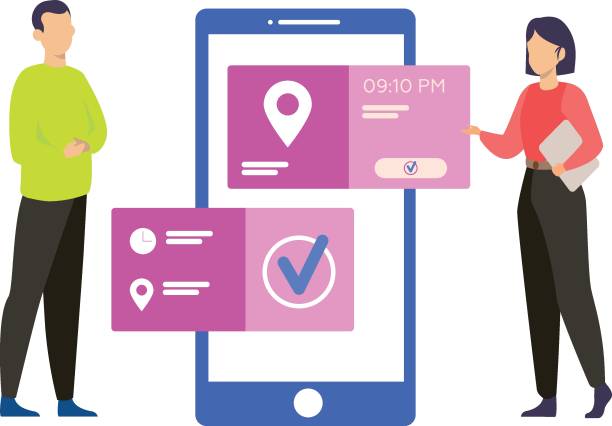
In the current digital age, where every business needs a powerful online presence, #Modern_UI_Website_Design is no longer a luxury, but a vital necessity.
To survive and thrive in a competitive market, your website must not only be beautiful, but also #user-friendly and #inclusive.
User Interface (UI) and User Experience (UX) are two key concepts that lie at the heart of every successful website design project.
Modern design, beyond visual appeal, means creating a smooth and enjoyable interaction between the user and the website.
This explanatory and educational approach will help you gain a deeper understanding of how a modern design impacts your business’s success.
A website with a modern user interface is your first point of contact with your audience.
Just as the decor of a physical store can attract or repel customers, your website’s design can influence visitors’ decisions.
If your website is complex, slow, or visually tiresome, users will quickly leave it and turn to your competitors.
In contrast, a website with an appealing visual interface, easy navigation, and fast loading speed not only attracts users but also keeps them engaged for longer, increasing the likelihood of converting visitors into customers.
This is where the importance of modern UI website design clearly manifests itself.
It involves using new technologies, adhering to responsive design principles, and paying attention to the minute details of user experience.
The educational content of this chapter emphasizes how a successful UI/UX design can also impact SEO (Search Engine Optimization).
Search engines like Google rank websites that offer a better user experience higher.
Factors such as low Bounce Rate, Dwell Time, and the number of pages viewed per visit are all influenced by the quality of the user interface and user experience.
Therefore, investing in modern UI website design means investing in your online future and success.
This approach is vital not only for aesthetics but also for your performance and business goals.
Ultimately, the final goal of a modern design is for the user to easily achieve their objective, whether it’s purchasing a product, finding information, or making contact.
Tired of your company’s website not being seen as it deserves and losing potential customers? Solve this problem forever with professional and effective website design by Rasavab!
✅ Increase brand credibility and earn customer trust
✅ Attract targeted sales leads
⚡ Contact us now for a free consultation!
Key Principles in User-Friendly UI Design
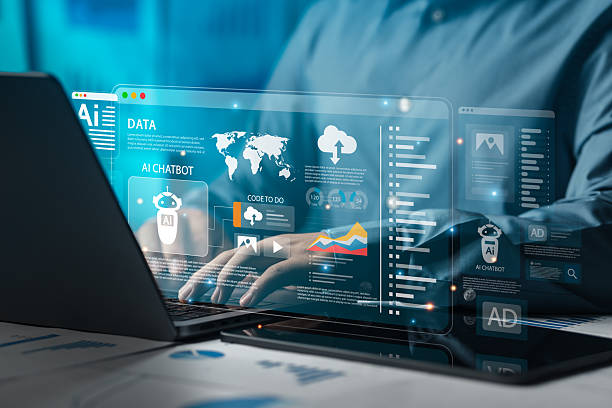
Deep within #UI_Design, there are principles and rules that, if applied correctly, create an unparalleled user experience.
For every modern UI website design project, understanding and applying these specialized principles is essential.
One of the most important principles is consistency and uniformity.
Users expect similar elements across the website to behave and appear the same way.
Buttons, forms, menus, and icons must follow a consistent visual and functional language across all website pages.
This consistency allows users to quickly become familiar with the site environment and achieve their goals without confusion.
Another principle is providing appropriate feedback.
When a user performs an action (e.g., clicks a button or submits a form), the website should provide feedback on whether their action was successful or not.
This feedback can include changing the button color, displaying a confirmation message, or even small animations.
Lack of feedback can confuse the user and discourage them from continuing to interact with the site.
This is a vital aspect of optimizing user experience.
Simplicity and Minimalism are also fundamental principles in modern UI/UX design.
Removing unnecessary elements and focusing on the main content helps users achieve their goals without distraction.
Every additional element creates more cognitive load for the user and may divert them from the main path.
A modern website should present information clearly and concisely.
Discoverability means that users should easily be able to find what they need.
Navigation menus should be clear and predictable, and content should be logically organized.
Using clear naming conventions for links and buttons also plays an important role in this regard.
Finally, Learnability is also of high importance.
A good user interface should be designed in such a way that users can easily learn how to use it, even on their first visit.
These principles are the cornerstone of any modern UI website design, and their correct implementation will lead to high user satisfaction and business success.
Precise guidance in this area can make a difference in your project.
Psychology of Color and Visual Elements in Modern Website Design
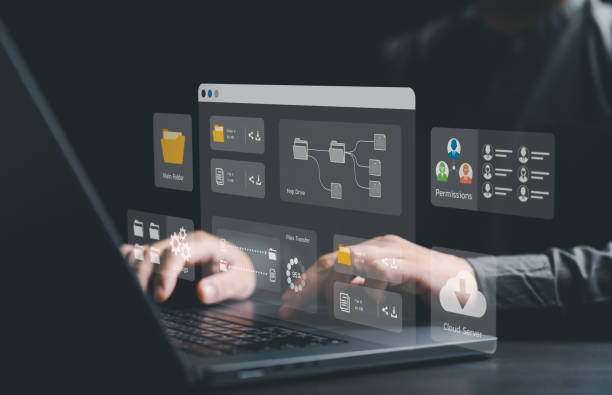
In #Modern_UI_Website_Design, beyond layout and functionalities, the psychology of color and visual elements plays a fundamental role in creating a lasting and impactful user experience.
Colors not only beautify your website but can also evoke specific emotions in visitors and influence their decision-making.
This specialized and educational section examines how to strategically use colors and other visual elements to enhance the quality of website design with modern UI/UX.
Every color carries its own message and meaning.
For example, blue is typically associated with trust, calm, and professionalism, which is why it’s often seen on banking and technology websites.
Green represents nature, growth, health, and freshness, making it suitable for websites related to the environment or organic products.
Red can convey passion, excitement, and urgency, but overuse may cause anxiety.
Yellow evokes joy and optimism, while black can convey a sense of power, sophistication, and elegance.
The table below lists some common color meanings:
| Color | Common Meanings | Website Application Examples |
|---|---|---|
| Blue | Trust, Calm, Professionalism | Banks, Technology Companies, Healthcare Websites |
| Green | Nature, Growth, Health, Freshness | Environment, Organic Products, Finance |
| Red | Passion, Excitement, Urgency, Energy | “Buy Now” Buttons, Warnings, Entertainment |
| Orange | Enthusiasm, Creativity, Warmth | Creative Websites, Educational, Call-to-Action Buttons |
| Purple | Luxury, Creativity, Spirituality | Beauty, Luxury, Fashion |
Choosing the right color palette for modern UI website design requires a precise understanding of the target audience, branding, and the message you intend to convey.
In addition to color, other visual elements such as typography (fonts), images, icons, and negative space (white space) also play a vital role.
Appropriate typography not only enhances readability but can also reflect your brand’s personality.
High-quality and relevant images make the website more attractive and visually convey your message.
Intelligent use of negative space also allows your website to “breathe” and prevents visual clutter, which is essential for modern design.
All these elements together provide a unified and pleasant visual experience for the user and significantly contribute to the success of modern UI website design.
New UI/UX Design Trends in 2024
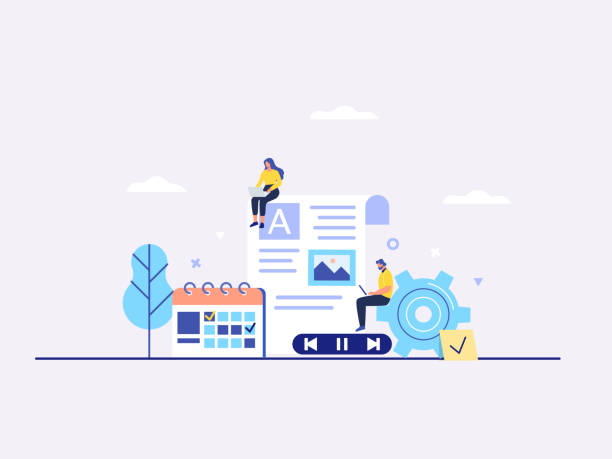
The world of #Web_Design is constantly evolving, with new trends emerging every year that fundamentally change the user experience.
Understanding these trends is vital for anyone looking for modern and competitive UI website design.
This news and analytical section takes a look at the latest and most important UI/UX design trends in 2024 that will put your website at the forefront of innovation.
One of the most important trends is Dark Mode design.
With increasing user screen time, dark mode not only reduces eye strain but also offers a modern and sleek experience that many users prefer.
Leading websites have provided the option to switch between light and dark modes.
Micro-interactions are also becoming widespread.
These small and subtle animations, such as a button changing color upon click, or an engaging loading animation, provide delightful visual feedback to the user and add personality to the website.
These small details have a big impact on user experience and make the website more dynamic.
AI-driven Personalization is another powerful trend.
Using AI algorithms, websites can customize their content, products, or even their user interface based on each user’s behavior and preferences.
This approach creates a unique and highly relevant experience for every visitor and significantly increases conversion rates.
This is a big step towards improving user experience.
Inclusive Design has also gained increasing importance.
This means designing a website that is accessible to all individuals, regardless of their abilities.
Using appropriate color contrasts, adjustable font sizes, and support for assistive tools (like screen readers) are among the aspects of inclusive design that are highly crucial in modern UI website design.
Furthermore, Buttonless Navigation or Gesture-based Navigation, mostly seen on mobile devices, is gradually moving towards desktop as well, offering a minimalist and modern approach to website navigation.
Finally, 3D Graphics and Animations have become more feasible with advancements in web technology, making websites visually very rich and attractive, which is also an inseparable component of modern UI website design.
Does your current corporate website present a worthy image of your brand and attract new customers?
If not, turn this challenge into an opportunity with Rasavab’s professional corporate website design services.
✅ Significantly improves your brand’s credibility and image.
✅ Paves the way for attracting new leads and customers.
⚡ Contact Rasavab now for a free and specialized consultation!
The Importance of Responsiveness and Mobile-Friendliness in Modern Design

In today’s world, where #Mobile_Devices have become the primary tool for internet access, #Responsiveness and #Mobile-Friendliness are no longer extra features but are considered the main pillars of any modern UI website design.
This explanatory and specialized section clarifies the fundamental importance of these concepts for your website’s success.
Ignoring responsive design means losing a significant portion of your audience and website traffic.
Responsive Design means that your website can automatically adapt its layout, images, and content to the screen size of the device the user is using (from smartphones and tablets to laptops and televisions).
This adaptability ensures that users will have the best possible user experience, no matter what device they are on.
Texts are displayed correctly, images resize appropriately, and menus are organized in a user-friendly manner for every screen size.
The importance of mobile-friendliness can be examined from several aspects.
Firstly, most internet users today access the web via smartphones.
If your website does not display correctly on mobile, you not only create a poor user experience but also quickly lose users.
Secondly, search engines like Google prioritize mobile-friendly websites in their rankings.
Google’s “Mobile-First Indexing” algorithm means that the mobile version of your website is considered the primary version for indexing and ranking.
Therefore, a mobile-friendly website is crucial for your SEO and visibility.
A modern and responsive UI website design reduces Bounce Rate and increases the time users spend on the site.
Users tend to stay on websites that are easy and enjoyable to use, regardless of the device they are using.
This, in turn, helps to increase conversion rates, boost sales, and improve your brand’s credibility.
Responsive design helps you reach a wide range of users with a single design, eliminating the need to develop separate versions for each device, which saves both time and cost.
Ultimately, focusing on responsiveness is an integral part of any modern UI website design project aiming for long-term online success.
Essential Tools and Software for UI Designers
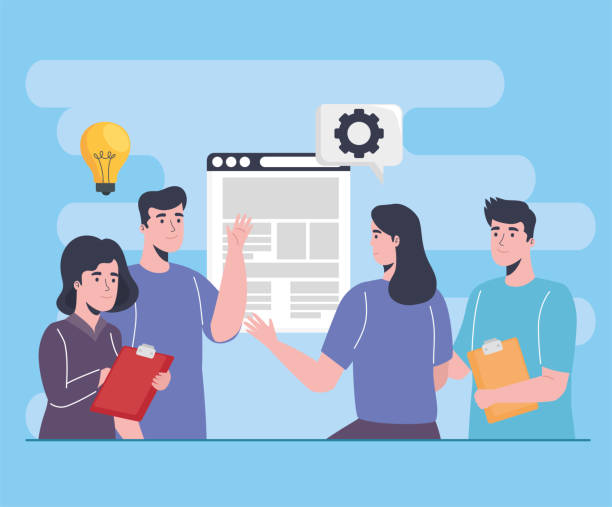
To achieve an efficient and #Modern_UI_Website_Design, designers need a set of advanced #Software_Tools to turn their ideas into reality.
This educational and guidance section introduces some of the most important and widely used tools in UI/UX design that every professional web designer should be familiar with.
Choosing the right tool can make a significant difference in the speed, quality, and efficiency of your project.
One of the most popular UI design tools currently is Figma.
Figma is a browser-based design tool that allows for real-time, simultaneous collaboration among team members.
This feature makes it ideal for large teams and complex projects.
With Figma, you can design Wireframes, Prototypes, and Design Systems, and receive live feedback.
Figma’s flexibility and accessibility have made it a powerful tool for modern UI/UX website design.
Adobe XD is another powerful tool in this field, developed by Adobe.
This tool is specifically optimized for UI/UX design and provides features such as wireframing, prototyping, and creating simple animations.
Adobe XD integrates well with other Adobe products like Photoshop and Illustrator, which is a significant advantage for designers using the Adobe ecosystem.
Sketch is a popular tool for Mac designers, known for its simple user interface and extensive plugin ecosystem.
Sketch is specifically built for UI/UX design, offering features like unlimited artboards, reusable symbols, and shared styles.
Although Sketch is only available for macOS, it still has a large user community.
In addition to the main design tools, other tools are also essential to complete the modern UI website design process.
For project management and team collaboration, tools like Jira or Asana are useful.
For graphic design and image editing, Photoshop and Illustrator still hold their ground.
For testing prototypes and gathering user feedback, tools like UserTesting or Maze can be helpful.
Ultimately, the choice of tools depends on project needs, team size, and the designer’s personal preferences, but proficiency in at least one of the main UI/UX design tools is mandatory for every modern web designer.
Testability and User Experience Improvement
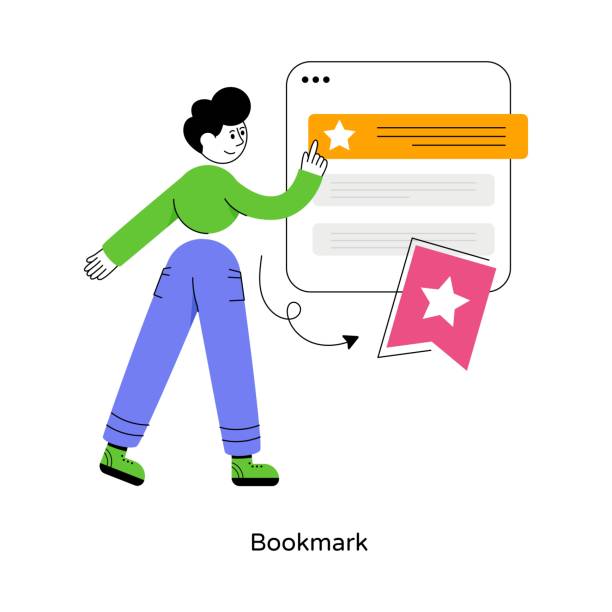
Building a #Modern_User_Interface is just the first step; maintaining and improving it through #Testability and continuous feedback is another vital part of the modern UI website design process.
This specialized and analytical section delves into the methods and tools that help you ensure your website is not only beautiful but also truly efficient and enjoyable for users.
Without testing, you will only rely on guesswork.
One of the most common methods for evaluating user experience is User Testing.
In this method, real users interact with your website, and their behavior, reactions, and feedback are recorded and analyzed.
This can include guided scenarios, where users perform specific tasks, or unscripted tests to observe their natural behavior.
Direct feedback from users provides the most valuable information for improving the user interface.
A/B Testing is also a powerful optimization method.
In this method, two different versions (A and B) of a page or an element (such as a call-to-action button) are shown to users, and the performance of both versions is compared based on metrics such as click-through rate or conversion rate.
This allows you to make decisions based on real data and implement changes that genuinely help improve your website’s performance.
For analyzing user behavior on a larger scale, using Web Analytics tools like Google Analytics is essential.
These tools provide information about website traffic, visited pages, user dwell time, bounce rate, and traffic sources.
Behavioral patterns extracted from this data can reveal the strengths and weaknesses of your user interface.
Heatmaps and Session Recordings are also powerful visual tools that show exactly where users click, where they scroll, and how they navigate pages.
These provide valuable visual information for designers to make better decisions for improving their modern UI website design.
| Method | Description | Main Benefit |
|---|---|---|
| User Testing | Observing real users while they interact with the site | Identifying navigation and usability issues |
| A/B Testing | Comparing two versions of an element to determine better performance | Optimizing conversion rate and increasing element effectiveness |
| Web Analytics | Analyzing traffic data and user behavior on a large scale | Discovering general behavioral patterns and strengths/weaknesses |
| Heatmaps | Visual representation of clicked and scrolled areas | Visual understanding of user interaction with the page |
A culture of continuous improvement and iteration in the design process is a key factor in a website’s long-term success.
After each round of testing, you should analyze the data, implement necessary changes, and then retest.
This feedback and improvement loop ensures that your modern UI website design will always evolve and align with user needs.
Challenges and Solutions for Designing Complex User Interfaces
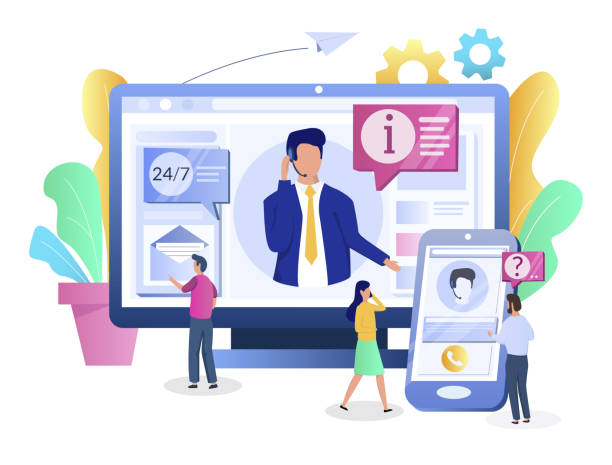
Although #Modern_UI_Website_Design aims for simplicity and efficiency, in many cases, websites face #Inherent_Complexities that create unique challenges for designers.
This section provides thought-provoking and analytical content to answer the question of how to design a modern and efficient user interface for systems with extensive information or complex functionalities.
Is “less always more”?
One of the biggest challenges is managing large volumes of information and data.
News websites, e-commerce platforms with thousands of products, or complex administration panels all face this challenge.
The main solution here is intelligent Information Architecture.
Using logical categorizations, powerful filters, advanced search capabilities, and clear visual hierarchies can help users easily navigate through vast amounts of data.
Designing a modern user interface in these circumstances means simplifying complexity, not hiding it.
Another challenge is functional complexity.
Some websites and applications allow users to perform highly complex tasks, such as online graphic design software or project management platforms.
In these cases, the design should allow users to gradually become familiar with advanced functionalities while still easily performing simple tasks.
Using step-by-step guides, tooltips, and modular user interfaces whose functionalities are activated based on user needs can be very effective.
Also, interference with Legacy Systems can be a significant challenge.
Many organizations have old internal systems that need to be integrated with a new user interface.
Modern UI website design in this scenario requires precise engineering and intelligent solutions to bridge between new and old technologies without compromising user experience.
This is a specialized field that demands high technical and design expertise.
One of the analytical and effective solutions to tackle complexity is breaking down complex tasks into smaller, manageable steps.
Instead of presenting a long and complicated form, divide it into several stages.
This approach reduces the user’s cognitive load and increases the likelihood of successful task completion.
Ultimately, continuous testing with real users is essential for identifying problematic areas and continuously improving the user interface, even in the most complex systems.
Designing a modern user interface for complex systems is not only an art but also a science that requires a deep understanding of user behavior and available technologies.
Did you know that 94% of a company’s first impression is related to its website design?
Rasavab, with its professional corporate website design services, helps you create the best first impression.
✅ Create a professional and trustworthy image for your brand
✅ Easier attraction of potential customers and improved online standing
⚡ Get a free corporate website design consultation
Success Stories in Modern UI Website Design
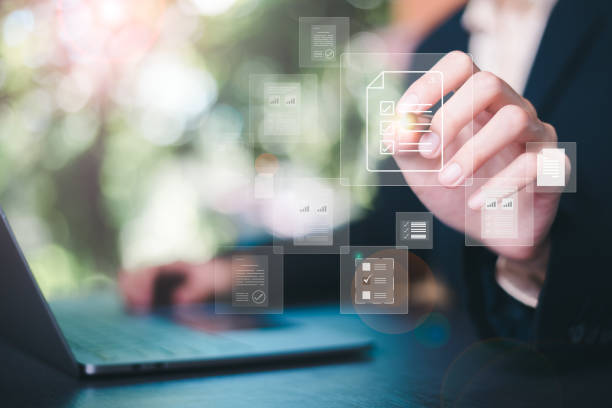
#Modern_UI_Website_Design is not merely a theoretical concept; rather, it’s a strategy that many leading companies have used to achieve remarkable success.
This entertaining and informative section examines several inspiring success stories that demonstrate how investing in modern UI/UX can not only strengthen branding but also lead to business growth and increased customer loyalty.
One of the most prominent examples in this regard is Airbnb.
Before Airbnb’s emergence, booking accommodations was primarily done through hotels and traditional agencies.
However, Airbnb revolutionized the tourism industry by offering a highly visual, simple, and user-friendly interface.
Their website and application design allow users to easily search for desired places, communicate with hosts, and make reservations.
High-quality photos, interactive maps, and a user feedback system all contributed to creating a trustworthy and enjoyable experience.
Airbnb’s success is a testament to the power of modern UI website design in transforming industries.
Another example is Spotify.
This music streaming platform managed to attract millions of users by offering a highly personalized and engaging user interface.
Their design allows users to easily access millions of songs, create personal playlists, and discover new music based on their taste.
The combination of dark colors, clear typography, and intelligent use of white space, along with advanced personalization features, has made Spotify a prominent example of a modern and successful user interface.
Stripe, the online payment company, is another example of such successes.
In an industry typically known for technical complexities and tedious user interfaces, Stripe attracted developers by offering a very clean, simple, and efficient API and dashboard.
Their minimalist yet powerful design significantly simplified the process of implementing online payments for businesses.
This simplicity and efficiency are core elements in modern UI website design that Stripe has successfully employed.
These stories demonstrate how good design can act as a powerful competitive advantage, helping businesses stand out in crowded markets and achieve sustainable growth.
These real-world examples are inspiring for anyone looking to build an exceptional website.
Ethical Challenges and Responsibilities in UI Design

While #Modern_UI_Website_Design offers countless benefits, one should not overlook the #Ethical_Challenges and responsibilities that fall upon designers and developers.
This thought-provoking and analytical section explores the less-seen and sometimes controversial aspects of UI/UX design.
Is design always serving the user, or can it become a tool for manipulation?
One of the most important challenges is Addictive Design.
Many applications and websites use psychological techniques and attractive visual elements to encourage users to spend more time on the platform.
This includes persistent notifications, variable reward designs (like pull-to-refresh that mimics slot machines), and excessive gamification.
While the goal is to increase engagement, this approach can lead to digital addiction and negative impacts on users’ mental health.
Designers must use these techniques responsibly and recognize the line between engaging users and exploiting their attention.
Another challenge is data transparency and privacy.
Modern UI website design often involves collecting a large volume of user data to provide a personalized experience.
But are these data collected transparently, and are users aware of how they are used? The use of “Dark Patterns,” which are designs that trick users into doing things they otherwise wouldn’t (e.g., unintended purchases or newsletter subscriptions), is a serious ethical challenge.
Designers are responsible for ensuring that data collection processes and privacy options are presented clearly and understandably to users.
Inclusivity and Accessibility also represent an important ethical dimension.
A modern UI website design must be accessible to all individuals, including those with disabilities.
Ignoring this aspect means depriving a large segment of the population from accessing online information and services.
This is not only a legal requirement in many countries but also an ethical responsibility.
Finally, the environmental impact of digital design is also emerging.
Heavy and unoptimized websites consume more energy, adding to the digital carbon footprint.
Lightweight, optimized, and efficient designs not only improve user experience but also contribute to environmental preservation.
These ethical questions and challenges require designers to continuously assess their responsibilities and make decisions that benefit not only the business but also users and society.
Frequently Asked Questions
| Question | Answer |
|---|---|
| What is a modern user interface? | A modern user interface refers to a design that utilizes new trends, simplicity, excellent user experience, and attractive visual elements. |
| Why is using a modern user interface important in website design? | It leads to attracting and retaining more users, creating a professional feel, improving user experience, and increasing conversion rates. |
| What are the main features of a modern user interface? | Simplicity, sufficient use of white space, readable typography, attractive and harmonious colors, subtle animations, and responsive design. |
| How is responsiveness related to a modern user interface? | Responsive design is an essential feature in modern user interfaces that ensures the site is displayed well across all devices (mobile, tablet, desktop). |
| What is the role of typography in modern user interface design? | Choosing appropriate fonts and using them correctly enhances readability and contributes to the site’s beauty and visual identity. |
| What is White Space and why is it important in modern UI? | It is the empty space between various elements on a page, which helps improve readability, user focus, and creates a sense of cleanliness and order. |
| What is the benefit of using animations in modern UI design? | Subtle and purposeful animations can capture user attention, improve interaction, and make information transfer more engaging. |
| How can user experience (UX) be improved alongside a modern user interface? | By understanding user needs, simplifying navigation paths, providing appropriate visual feedback, and easy testability. |
| Does a modern user interface always mean using bright colors? | No, a modern user interface can use various color palettes, including dark colors; the important thing is choosing harmonious and brand-appropriate colors. |
| What are the current trends in modern user interface design? | The use of Dark Mode, Neumorphism, Glassmorphism, scroll-based animations, and minimalist design. |
And other services of RasaWeb Advertising Agency in the field of advertising
Smart Customer Journey Map: Designed for businesses seeking online growth through SEO-driven content strategies.
Smart Advertising Campaign: A dedicated service for growing campaign management based on marketing automation.
Smart Brand Identity: Designed for businesses seeking online growth through the use of real data.
Smart Advertising Campaign: A professional solution for digital branding focusing on intelligent data analysis.
Smart SEO: A novel service for increasing website visits through SEO-driven content strategies.
And over hundreds of other services in the field of internet advertising, advertising consulting, and organizational solutions
Internet Advertising | Advertising Strategy | Advertorial
Sources
Modernizing Website User Interfaces
The Future of Website Design and AI
10 Principles of Efficient User Interface Design
Why You Should Update Your Website?
? Are you looking to elevate your business in the digital world? Rasavab Afarin Digital Marketing Agency, by offering comprehensive SEO-optimized website design services, helps you shine online and achieve your goals. With us, experience a powerful and memorable presence.
📍 Tehran, Mirdamad Street, next to Bank Markazi, Kazerun Jonubi Alley, Ramin Alley, No. 6

